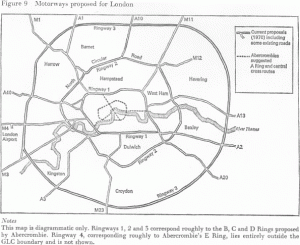Agile development comes in various forms and flavours. Each workplace does it differently; some do four-week iterations, others two-week sprints; some use scrum, others xp, and then most will just improvise and make up their own rules – or as Alistair Cockburn, one of the Agile Manifesto writers talks about in his lectures: ‘Shu-Ha-Ri’: Learn, Collect, Invent. But the main principles remain the same: small, incremental iterations, adapting to changing circumstances, with quick feedback loops through continuous integration and smart unit tests.
At some point in time, somebody thought the same principles could be applied to the built environment. After all, we’ve all seen developments that took twenty years to plan; then when the plans finally went through all the committees, the economic and social conditions had changed and these projects remained on paper.
One fairly good example is London’s motorway system, a comprehensive solution to London’s traffic problems first suggested by Abercrombie with no less than five ring roads. Implementation started in the early sixties and was finally abandoned twenty years later as it became irrelevant and unpopular. If implemented, parts of the UCL Bloomsbury campus (ironically where Abercrombie himself taught) would have been bulldozed in favour of a multi-lane highway cutting through central London to make room for more vehicles. One of the main faults of the plan was that it failed to correctly examine the data and trajectories of future car use, conveniently overlooking how adding more roads in one place simply shifts the problem over to another, as we all too well know.

The advocates for incremental planning claim that rather than trying to predict the future, with complicated models trying to incorporate an impossible amount of data, our aim should be instead to develop one small project at a time, always thinking of our current needs. Most buildings go up within a year or so, so why plan any further than that?
Unsurprisingly, this incremental development approach is quite popular with those who believe in letting the market forces lead the development of our cities. The same people would also argue that once pinpoint decisions are made for each project, the role of the town planner is redundant, since an overarching, or master plan that puts all the pieces together goes against the very notion of incremental development and is an unnecessary government intervention wasting taxpayers’ money. The next step would then be to close down all town planning offices and dismiss all town planners, leaving urban development to our friend the “invisible hand”.
If you’re getting a feeling of déjà-vous, that is because the establishment of the town planning profession was the direct response to this very same notion. Ebenezer Howard’s Garden City movement and Le Corbusier’s Radiant City were a reaction to the decaying and (quite literally) sick industrial revolution’s urban environments. Market forces, without any guidance, failed to put any thought into how buildings related to their surroundings; what kind of long-term effect they would have on the neighborhood; what benefits others would get from them and who would stand to lose from having their view obstructed or their front yard facing a factory instead of a park or a public open space.
We all complain when we see an ugly structure or street, but fail to acknowledge that all the beautiful cities we can think of didn’t just appear out of the selfish, short-sighted concerns of each individual developer. If left to their own devices developments would probably just wall themselves in and create inner-facing private parks for their own amusement.
And while software is a commodity sold for whoever’s willing to pay for it (thus the only consideration when developing software is “will the customer be happy with it”), in the built environment the long-term benefits have to be considered and managed by someone, otherwise nobody’s going to pick up the bill.


